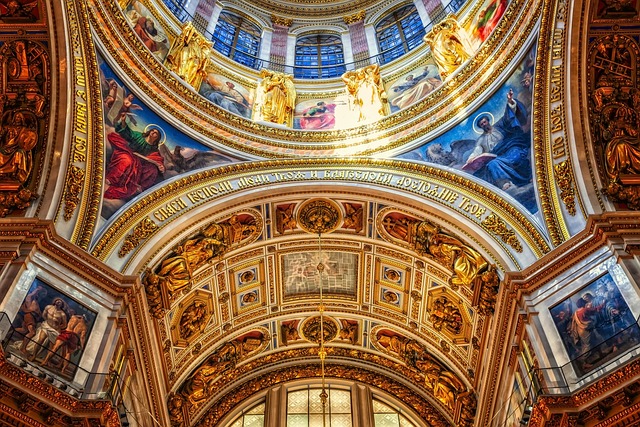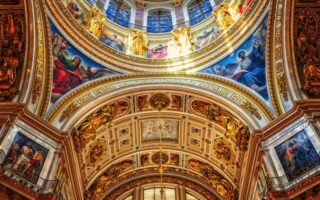Orthodox Christianity originated in the 1st century AD as a result of the teachings and ministry of Jesus Christ and his apostles. It developed as a distinct branch of Christianity, separate from Roman Catholicism, due to theological, cultural, and political differences. The early centers of Orthodox Christianity were primarily in the Eastern Mediterranean region, particularly in cities such as Jerusalem, Antioch, and Alexandria. Over time, the Orthodox Church expanded its influence and became the dominant form of Christianity in the Byzantine Empire. Today, Orthodox Christianity is one of the major branches of Christianity, with millions of adherents worldwide.
Table of Contents
The Origins and Early Development of Orthodox Christianity
Orthodox Christianity, one of the oldest branches of Christianity, has a rich and fascinating history that dates back to the early days of the faith. In this article, we will explore the origins and early development of Orthodox Christianity, shedding light on how this ancient tradition came to be.
To understand the beginnings of Orthodox Christianity, we must first delve into the early years of the Christian movement. It all started with Jesus Christ, who is considered the central figure of the faith. Jesus, born in Bethlehem, preached a message of love, forgiveness, and salvation to his followers. His teachings and miracles attracted a significant following, which eventually led to his crucifixion and resurrection.
After Jesus’ resurrection, his disciples, known as the apostles, spread his teachings throughout the Roman Empire and beyond. These apostles played a crucial role in the early development of Christianity, as they carried the message of Jesus to different regions and established communities of believers.
One of the most prominent apostles was Peter, who is often referred to as the first bishop of Rome. Peter’s leadership and influence were instrumental in the growth of the early Christian community. Over time, the bishop of Rome became recognized as the head of the Church, and this position eventually evolved into the papacy.
As Christianity spread, different regions developed their own distinct practices and traditions. The early Christian communities in the Eastern Mediterranean, including Jerusalem, Antioch, and Alexandria, had their own unique ways of worshiping and interpreting the teachings of Jesus. These communities formed the foundation of what would later become known as Orthodox Christianity.
The term “Orthodox” itself comes from the Greek word “orthodoxia,” which means “right belief” or “correct doctrine.” The early Christians who adhered to the teachings and practices of the apostles and their successors considered themselves to be the true followers of Christ, holding steadfast to the original teachings of the faith.
In the early centuries of Christianity, the Church faced numerous challenges and controversies. One of the most significant debates was the question of Christ’s nature. Some believed that Jesus was purely divine, while others argued that he had both a divine and human nature. This debate led to the Council of Chalcedon in 451, where the orthodox position, known as the Chalcedonian Definition, was affirmed.
The Council of Chalcedon marked a crucial turning point in the development of Orthodox Christianity. It solidified the Church’s understanding of Christ’s nature and set the foundation for its theological framework. From that point on, Orthodox Christianity continued to grow and flourish, spreading its influence throughout the Byzantine Empire and beyond.
Throughout its history, Orthodox Christianity has faced various challenges, including persecution, schisms, and political conflicts. However, it has managed to endure and maintain its distinct identity. Today, Orthodox Christianity is practiced by millions of believers worldwide, with its spiritual and liturgical traditions deeply rooted in the early years of the faith.
In conclusion, the origins and early development of Orthodox Christianity can be traced back to the teachings of Jesus Christ and the apostles. Through the efforts of these early followers, the faith spread and evolved, eventually giving rise to the distinct traditions and practices that define Orthodox Christianity today. Despite the challenges it has faced, this ancient tradition continues to thrive, offering spiritual guidance and a connection to the early roots of the Christian faith.
Key Figures and Events in the Formation of Orthodox Christianity

Orthodox Christianity, one of the oldest branches of Christianity, has a rich history that dates back to the early days of the faith. Understanding how it all began requires delving into the key figures and events that shaped the formation of Orthodox Christianity.
One of the most influential figures in the early days of Orthodox Christianity was Saint Peter, one of Jesus’ twelve apostles. According to tradition, Peter was appointed by Jesus himself as the leader of the apostles, giving him a central role in the early Christian community. Peter’s leadership and teachings laid the foundation for what would later become Orthodox Christianity.
Another key figure in the formation of Orthodox Christianity was Saint Paul. Originally a persecutor of Christians, Paul underwent a dramatic conversion on the road to Damascus and became one of the most important early Christian missionaries. His letters, which make up a significant portion of the New Testament, played a crucial role in shaping Christian theology and spreading the faith to different regions.
As Christianity spread throughout the Roman Empire, it faced numerous challenges and controversies. One of the most significant events in the early history of Orthodox Christianity was the Council of Nicaea in 325 AD. This council was called by Emperor Constantine to address the Arian controversy, which centered around the nature of Jesus Christ. The council affirmed the divinity of Jesus and established the Nicene Creed, a statement of faith that remains central to Orthodox Christianity to this day.
Another important event in the formation of Orthodox Christianity was the Great Schism of 1054. This event marked the formal split between the Eastern Orthodox Church and the Roman Catholic Church. The schism was the result of a combination of theological, political, and cultural differences that had been brewing for centuries. The Eastern Orthodox Church, centered in Constantinople, rejected the authority of the Pope and emphasized the importance of the Holy Spirit in the life of the Church.
Throughout its history, Orthodox Christianity has been shaped by the lives and teachings of numerous saints and theologians. One of the most revered figures in Orthodox Christianity is Saint John Chrysostom, a fourth-century bishop known for his eloquent preaching and strong emphasis on social justice. His writings on the importance of caring for the poor and marginalized continue to inspire Orthodox Christians today.
Another influential figure in Orthodox Christianity is Saint Gregory Palamas, a fourteenth-century monk and theologian. Palamas is known for his teachings on the distinction between God’s essence and energies, which became a central aspect of Orthodox theology. His writings on prayer and the mystical experience of God continue to be studied and revered by Orthodox theologians.
In conclusion, the formation of Orthodox Christianity was shaped by key figures and events throughout history. From the leadership of Saint Peter and Saint Paul to the Council of Nicaea and the Great Schism, these figures and events played a crucial role in shaping the beliefs and practices of Orthodox Christians. Today, Orthodox Christianity continues to be a vibrant and enduring branch of the Christian faith, with a rich history that stretches back to its earliest days.
Theological Beliefs and Doctrines of Orthodox Christianity
Orthodox Christianity, with its rich history and deep-rooted traditions, has captivated the hearts and minds of millions of believers around the world. But have you ever wondered how this ancient faith came to be? In this article, we will explore the theological beliefs and doctrines that form the foundation of Orthodox Christianity.
At the core of Orthodox Christianity lies a firm belief in the Holy Trinity – the Father, the Son, and the Holy Spirit. This belief is rooted in the teachings of Jesus Christ and is considered the cornerstone of the faith. Orthodox Christians believe that God is one, yet exists in three distinct persons, each with their own unique role in the divine plan.
Another fundamental aspect of Orthodox Christianity is the veneration of icons. Icons are sacred images that depict Christ, the Virgin Mary, and various saints. These holy images are not worshipped, but rather serve as a means of connecting with the divine. Orthodox Christians believe that through icons, they can experience a tangible connection to the heavenly realm.
The sacraments, or mysteries, hold a significant place in Orthodox Christianity. These sacred rituals are seen as a means of receiving God’s grace and are essential for spiritual growth. The seven sacraments include baptism, chrismation, the Eucharist, confession, marriage, holy orders, and anointing of the sick. Each sacrament is believed to bestow specific spiritual blessings upon the recipient.
Orthodox Christians also place great importance on the liturgical worship. The Divine Liturgy, the central act of worship, is celebrated with great reverence and solemnity. The liturgy is a mystical experience that allows believers to participate in the heavenly worship of God. The use of incense, chanting, and elaborate vestments adds to the sense of awe and reverence during these sacred services.
The concept of salvation in Orthodox Christianity differs from some other Christian traditions. While many Christians believe in the concept of original sin, Orthodox Christians emphasize the idea of ancestral sin. This means that all humanity bears the consequences of Adam and Eve’s disobedience, but each person is responsible for their own sins. The goal of salvation is to restore the image of God within each individual and unite them with Christ.
Orthodox Christianity also places a strong emphasis on theosis, or divinization. This concept teaches that through a life of prayer, repentance, and participation in the sacraments, believers can become more and more like God. Theosis is not about becoming divine in essence, but rather about acquiring the divine attributes and virtues that reflect the image of God.
In addition to these theological beliefs and doctrines, Orthodox Christianity also upholds a rich tradition of spirituality and asceticism. Monasticism, with its focus on prayer, fasting, and self-denial, has played a vital role in the development of Orthodox spirituality. Monks and nuns dedicate their lives to seeking union with God and serve as spiritual guides for the faithful.
In conclusion, the theological beliefs and doctrines of Orthodox Christianity form a solid foundation for this ancient faith. From the belief in the Holy Trinity to the veneration of icons, from the sacraments to the emphasis on liturgical worship, each aspect contributes to the unique and vibrant tapestry of Orthodox Christianity. Whether you are a believer or simply curious about this ancient faith, exploring these theological beliefs can deepen your understanding and appreciation for Orthodox Christianity.
The Spread and Influence of Orthodox Christianity throughout History
Orthodox Christianity, with its rich history and deep-rooted traditions, has had a significant impact on the world throughout the centuries. From its humble beginnings to its widespread influence, this article will explore how Orthodox Christianity started and its journey through history.
The origins of Orthodox Christianity can be traced back to the early days of Christianity itself. It emerged as one of the major branches of Christianity alongside Roman Catholicism and Protestantism. The term “Orthodox” comes from the Greek word “orthodoxia,” meaning “right belief” or “correct doctrine.” This branch of Christianity emphasizes the importance of preserving the original teachings and practices of the early Christian Church.
The spread of Orthodox Christianity began in the Eastern Roman Empire, also known as the Byzantine Empire, which encompassed present-day Greece, Turkey, and parts of the Middle East. The Byzantine Empire served as the center of Orthodox Christianity for many centuries, and its influence extended far beyond its borders.
One of the key figures in the early development of Orthodox Christianity was Emperor Constantine the Great. In the 4th century, he legalized Christianity and played a crucial role in the Council of Nicaea, which established the Nicene Creed, a statement of faith that remains central to Orthodox Christianity to this day.
As the Byzantine Empire expanded, so did the influence of Orthodox Christianity. Missionaries were sent to various regions, spreading the teachings of the faith and establishing new communities. The conversion of the Slavic peoples, particularly in Russia, was a significant milestone in the history of Orthodox Christianity. The Russian Orthodox Church became one of the largest and most influential Orthodox Churches, shaping the religious and cultural identity of the Russian people.
Throughout history, Orthodox Christianity faced numerous challenges and underwent periods of turmoil. The Great Schism of 1054 marked a significant division between the Eastern Orthodox Church and the Roman Catholic Church. This split was primarily due to theological differences and disputes over authority. The Eastern Orthodox Church maintained its independence and continued to flourish, while the Roman Catholic Church became the dominant branch of Christianity in the West.
The influence of Orthodox Christianity extended beyond religious matters. It played a crucial role in shaping the political, social, and cultural landscape of the regions where it thrived. Byzantine art and architecture, with its iconic domes and mosaics, left a lasting legacy that can still be seen in many Orthodox churches today. The liturgical music of Orthodox Christianity, characterized by its haunting melodies and intricate harmonies, has also had a profound impact on the development of music in various cultures.
In recent times, Orthodox Christianity has faced new challenges and opportunities. The fall of communism in Eastern Europe led to a revival of religious life, and Orthodox Christianity experienced a resurgence in many countries. The Orthodox Church has also become more globally interconnected, with increased dialogue and cooperation between different Orthodox Churches around the world.
In conclusion, Orthodox Christianity has a rich and diverse history that spans centuries. From its origins in the Byzantine Empire to its spread throughout Eastern Europe and beyond, it has left an indelible mark on the world. Its teachings, traditions, and cultural contributions continue to shape the lives of millions of people, making it a vibrant and enduring faith.
Conclusion
In conclusion, Orthodox Christianity originated from the early Christian Church and developed into a distinct branch of Christianity. It was influenced by various factors, including the teachings of Jesus Christ, the apostles, and the early Church Fathers. The Great Schism of 1054 marked the formal split between the Eastern Orthodox Church and the Roman Catholic Church, solidifying the separate identity of Orthodox Christianity. Today, Orthodox Christianity is practiced by millions of believers worldwide, with its own unique traditions, liturgy, and theological perspectives.
For licensing reasons, we must provide the following notice: This content was created in part with the help of an AI.


